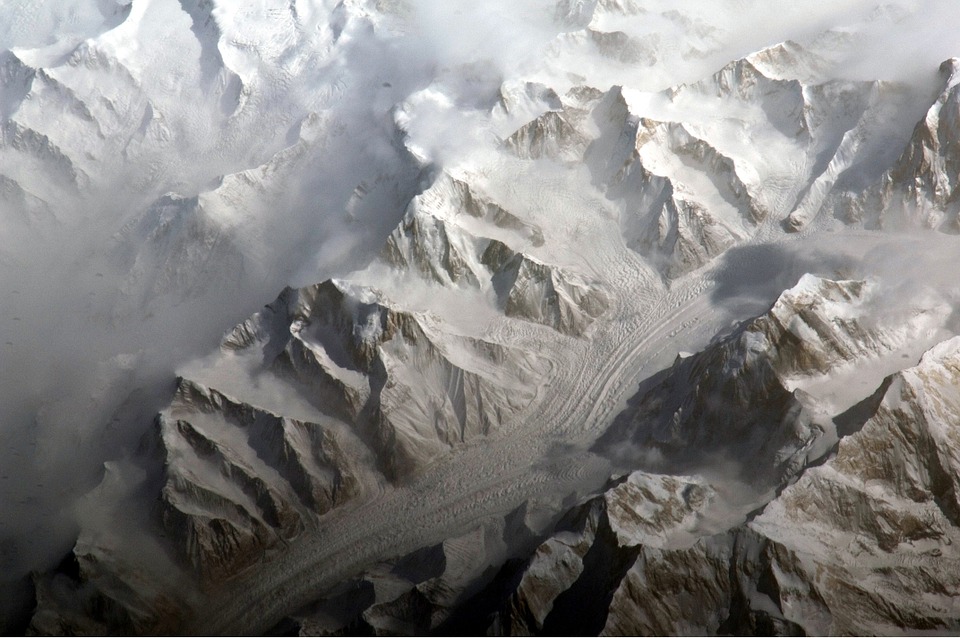What was Earth like during an Ice Age?
by Ailsa Harvey · 10/12/2019
Uncover the lost world of a frozen Earth

For most of Earth’s history, the planet has been free of ice, even at the poles. However, for the last 2.4 billion years, Earth has been cycling in and out of freezing ice ages. For millions of years at a time, temperatures plummet and large areas of the globe become trapped under sheets of ice. These glacial periods start gradually. Snow falls during the winter, and fails to melt in the summer, and over time, layer upon layer is built up. The white surface reflects sunlight back into space, and a cycle of cooling begins.
Vast glaciers form at the poles, creeping inwards towards the equator, and Earth’s water is locked away into slowly moving ice. As it creeps along, it carves great scars into the landscape beneath. When Earth’s water freezes, sea levels drop, revealing land once hidden beneath the oceans. Winds and currents change direction, and even those places untouched by ice undergo significant climate change.
There have been at least five ice ages so far, the first of which transformed the entire planet into a giant snowball. However, within these periods of extreme chill, there have been occasional bursts of warmth. During each ice age, the Earth cycles in and out of glaciation, freezing for tens of thousands of years, thawing temporarily, and then freezing again. As the glaciers warm, water floods back across the land, filling valleys and carving out new tracks in the landscape. Sea levels rise, and winds and currents shift. In fact, we are in the middle of an ice age right now – but we are in a temporary thaw that began around 11,000 years ago.
These warm periods are known as ‘interglacials’ and we don’t know exactly how long they last for. Ice sheets still cover Antarctica and Greenland, trapping 75 per cent of Earth’s fresh water, and when these finally melt, it will mark the end of the current ice age. Until then, join us as we delve into the history of ice on Earth.

Woolly mammoths were mammals capable of thriving during an ice age due to their thick hair and layers of insulating fat
What triggered the Ice Age?
The Earth’s temperature depends on where it’s at in its Milankovitch cycles. The Sun warms our planet, but the amount of heat we receive varies over years, decades and millennia. This is because Earth’s orbit, tilt and axis angle fluctuate in three different patterns, known as the Milankovitch cycles.
The first cycle is known as eccentricity. Earth moves around the Sun in an elliptical orbit, coming in close and then moving further away. However, the shape of this orbit changes over time, becoming more elongated (or ‘eccentric’) and rounder in a cycle that lasts 100,000 years.
The second cycle, known as obliquity, refers to the tilt of Earth relative to the plane of its orbit, which varies from 22.1 to 24.5 degrees over a 40,000-year period. The bigger the tilt, the more extreme the seasons are on our planet. Finally, Earth also wobbles as it spins, a little like a spinning top as it slows down. This wobble is known as precession, and it takes 26,000-years to complete one cycle.
The amount of solar energy that reaches Earth depends on where it is in all three Milankovitch cycles. At times when the planet receives the least energy, summer temperatures are coldest, and an ice age may be triggered. But the planet’s fate also depends on the position of continents, ocean circulation and composition of the atmosphere.
Did you know? Around 52 to 57 million years ago, Earth was so warm that there were trees in the Arctic and Antarctic
Geological evidence of an ice age
Ice sheets are made from layers of ice and snow, laid down year after year. As more layers build up, the ones below become compacted. Drilling down into glaciers allows researchers to recover cylinders known as ice cores, which contain information about the age of the ice and the climate at the time it was laid, tracing back hundreds of thousands of years. For information further back in time, sediment cores can be taken from the oceans, providing data about the Earth millions of years ago. More recently, scientists have used ice- penetrating radar to detect layers under the surface of the Greenland ice sheet.
Land bridges
When Earth’s water freezes into glaciers, sea levels drop, exposing land once hidden beneath the waves. These ‘land bridges’ connect islands and continents, allowing animals to move from one place to another. The most well-known is the Bering Land Bridge, which once linked Siberia to Alaska, closing the gap between Asia and North America. This bridge provided a sheltered path that took early humans to the Americas. In the past, solid ground has also appeared between the UK and Europe, connecting the islands of the Indonesian archipelago, and linking Australia to New Guinea.

Today, the Bering Strait is flooded with water
Is winter coming?
The impact of humans on Earth could affect the forecast. Technically, we are still in the middle of an ice age. The cold period that saw the rise and fall of woolly mammoths has not yet ended. We are in an interglacial period, and if history is anything to go by, these last for around 15,000 to 20,000 years.
11,000 years have already passed, but whether another cold snap is around the corner is a matter of debate. In the late 17th century, there was a Little Ice Age, during which time rivers froze and ice fields refused to melt during the summer. This is thought to have been caused by a period known as the Maunder Minimum.
The Sun’s changing magnetic field produces sunspots, which normally increase and decrease in a pattern that repeats every 11 years, but during the Little Ice Age, this cycle all but stopped. For 70 years, there were only around 50 recorded spots, when normally there would have been closer to 50,000.
In 2008, sunspots disappeared again, and when they eventually returned in 2014, they were weaker than at any other time on record. However, since the 17th century, humans have been busy expanding and industrialising, and, at least in part thanks to us, global temperatures are rising. Whether this will have an effect on the ice age cycle remains to be seen.
This article was originally published in How It Works issue 88
For more science and technology articles, pick up the latest copy of How It Works from all good retailers or from our website now. If you have a tablet or smartphone, you can also download the digital version onto your iOS or Android device. To make sure you never miss an issue of How It Works magazine, subscribe today!






